
Perth’s housing market has been a star performer over the past year, experiencing strong growth in both house prices and rents.
The evolution of the Perth housing market is illustrated by the next chart, which tracks detached house prices, as reported by the four main housing data providers: the Australian Bureau of Statistics (ABS); Australian Property Monitors (APM); RP Data-Rismark; and Residex, as well as a composite measure, which is the average of these indices. The ABS has the longest running house price series for Perth, going back to 1986, whereas APM’s is relatively new.
Unlike the major east coast capitals, where all four house price series tend to track each other closely over time, there are significant divergences in Perth, with the ABS providing the most positive results and Residex the most negative.
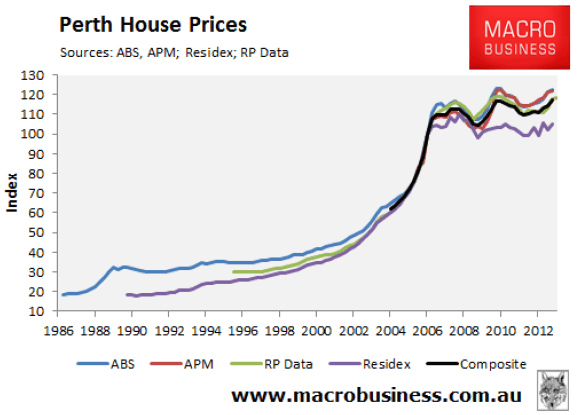
The most recent annual results show the Perth housing market growing at a solid clip. The ABS and APM, where results are available to March 2013, recorded house price growth of 6.1% and 5.4% respectively. RP Data, whose results are available up to June 2013, also recorded strong 5.8% growth, whereas Residex is the outlier, recording only 1.8% growth in the year to May 2012.
When adjusted for inflation, however, Perth house prices remain well below their 2006-07 peak, although prices are clearly recovering, Residex aside (see next chart).
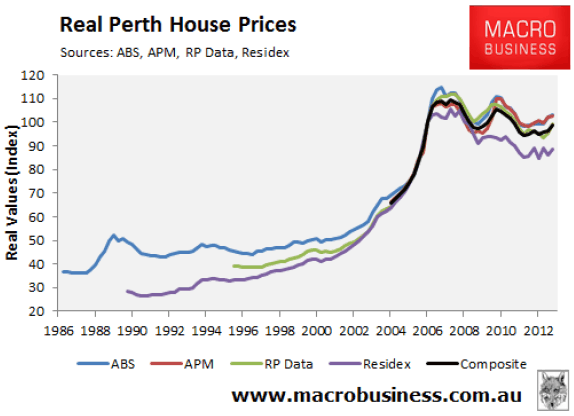
Focusing on the official ABS series only, you can see that Perth was late to the housing party. Whereas prices nationally began their upward march from the late-1990s, Perth houses did not begin to boom in value until 2003, in concert with the commencement of the commodities boom. Prices in Perth subsequently more than doubled in the three years to 2006, at a time when values nationally stagnated. Since 2006, however, Perth housing has underperformed the nation’s as a whole.
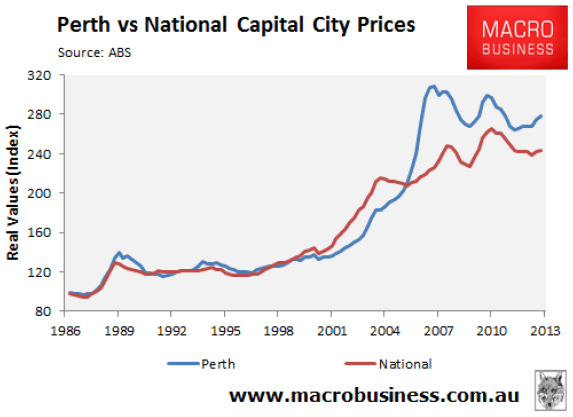
Perth’s rental market has exhibited even stronger growth. In the year to March 2013, Perth house rents rose by an astronomical 22.5%, according to APM, whereas Perth unit rents rose by 17.1% (house rental growth shown below).
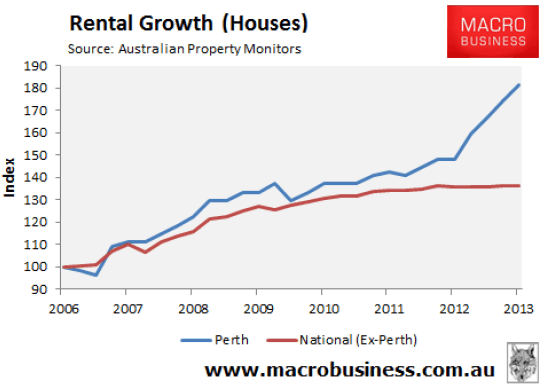
Following the strong rental growth, Perth’s median gross rental yields of 5.2% (houses) and 5.8% (units) are well above the other capitals, where gross yields of 4.7% (houses) and 5.1% (units) are on offer (house rental yields shown below).
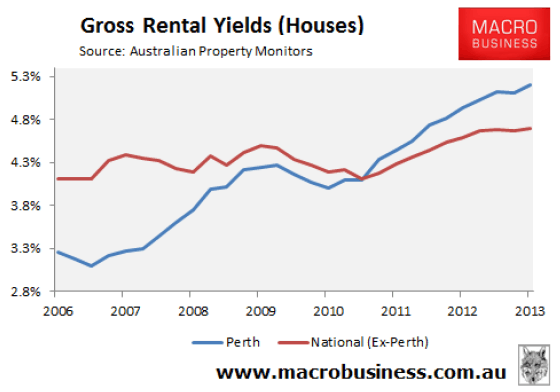
The strong growth in Perth house prices and rents has been driven, in part, by strong population growth, which has failed to be matched by increased housing construction (see next chart).
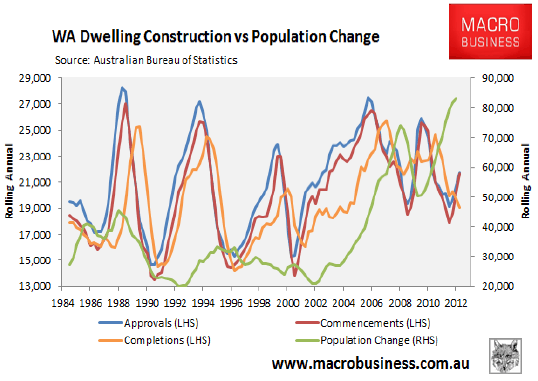
In fact, in the nine years to 2003, Western Australia built 160,412 dwellings for a 247,581 increase in the population, representing a population-to-construction ratio of 1.5. By comparison, in the nine years to 2012, Western Australia built 198,230 dwellings for a 506,587 increase in the population, representing a population-to-construction ratio of 2.6.
Mortgage demand has also pick-up significantly in Western Australia, with the total number of housing finance commitments (excluding refinancings) increasing by a seasonally-adjusted 30% in the year to May 2013 to be tracking well above the five-year moving average.
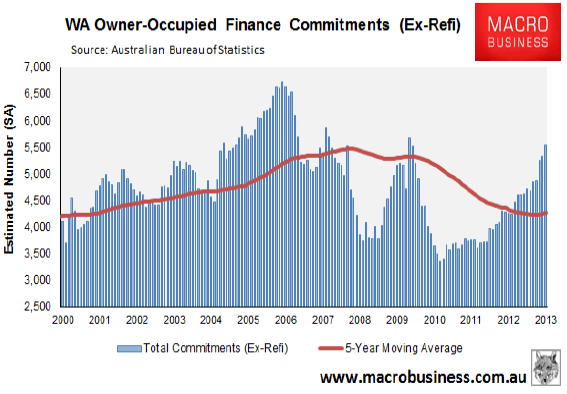
Importantly, demand from first home buyers in Western Australia has also risen strongly. The number of first home buyer mortgage commitments increased by 34% in the year to May 2013, and were tracking well above the five-year moving average. Further, the share of total finance commitments going to first home buyers was 24% in May 2013, also above the five-year moving average level of 22% (see next chart).
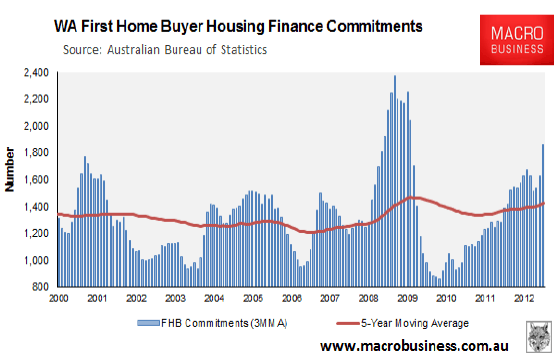
Storm clouds are on the horizon:
So much for where we’ve been, where are we going? Perth’s economy and employment market has, to date, been the strongest in the nation due to the once-in-a-century commodity price boom and mining-related capital investment.
The worm is turning, however, with the unwinding of both commodity prices (iron ore in particular) and mining investment threatening to cut Western Australia’s growth rate, reduce incomes and increase unemployment.
Iron ore is, by far, Western Australia’s key export commodity and a key driver of the state’s good fortune. Iron ore currently accounts for around half of Western Australian merchandise exports, up massively from only 16% of total exports in 2000 (see next chart).
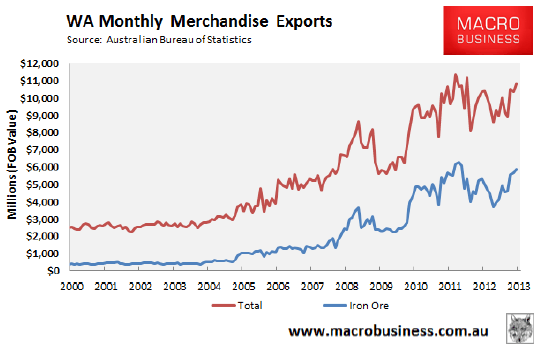
The strong growth in iron ore prices, which rose nearly ten-fold in the decade to 2011 before retracing, drove a huge surge in mining-related capital expenditures (capex), which hit a peak of 31% of Western Australian state final demand in June 2012, up from only around 8% a decade earlier (see next chart).
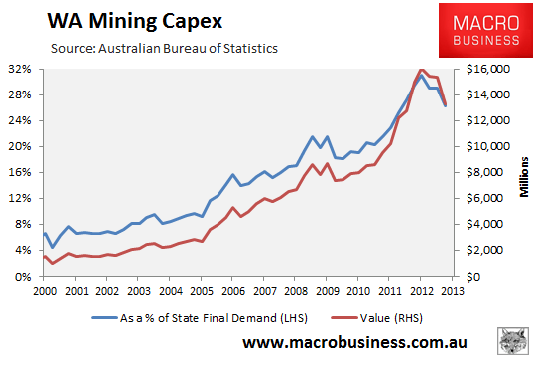
With the main buyer of Western Australian iron ore – China – now slowing and likely to become less resource-intensive as it shifts its growth model away from fixed asset investment, combined with rising global iron ore supplies, iron ore prices are likely to continue to decline.
Tens-of-billions of dollars’ worth of planned mining investments and exploration expenditures have already been cancelled across Western Australia and, as shown by the above chart, mining-related capex is already in decline with a long way further to fall.
From engineering to construction and ancillary mining services, tens-of-thousands of Western Australian jobs are now under threat as mining projects currently in the pipeline are completed, while incomes are also likely to come under pressure. Already, we have witnessed the beginning of this process, with a large number of mining services firms announcing profit downgrades and job cuts over the past two months.
The Western Australian Government is also set to come under increasing pressure, with the state facing falling revenues as lower iron ore prices reduce mining royalties. Any revenue shortfall increases the risk that the Government will make deep cuts to public sector services and jobs, as well as raise taxes, in a bid to shore-up the state’s finances, possibly exacerbating any downturn.
LNG support or second leg down?
There is one offset to the increasingly obvious iron ore bust. LNG is also a significant part of WA’s post-GFC mining boom. The two major projects are Gorgon and Wheatstone, which offer a combined total of $81 billion in investment. Gorgon is Australia’s largest LNG project and is scheduled to begin production in early 2015, Wheatstone one year later.
The ongoing spend on development of these mega-projects will support WA’s labour market for the next two years. As well, the WA government receives gas royalties, either directly or via Commonwealth taxes and give-back agreements, which can support the budget once production kicks in.
However, there are reasons to think that the LNG boom will only mitigate and not prevent downside risks for the WA economy. LNG has far fewer local multiplier effects than traditional mineral ore mining, largely because much of the equipment and expertise is imported. This is why the Barnett government is currently fighting a rear-guard action against the shift towards floating LNG projects (in which mining and processing is all done on huge ships). Take away the construction jobs available in onshore processing and there’s isn’t a lot of local benefit left beyond a boost to taxes.
Moreover, the two mega-projects’ combined spending is already close to or past its peak, also withdrawing from growth in the near future and increasing the negative multiplier effects as well as putting more pressure on the labour market.
The entry of cheaper US LNG into the Pacific Rim market means no new LNG projects will be approved.
From economic boom to economic bust?
Already, the slowing mining investment is having a detrimental impact on key macroeconomic indicators.
State final demand – a proxy for gross state product – had for much of the past decade exceeded the other mainland states. However, it has declined for two consecutive quarters, suggesting that the Western Australian economy might be headed into recession (see next chart).
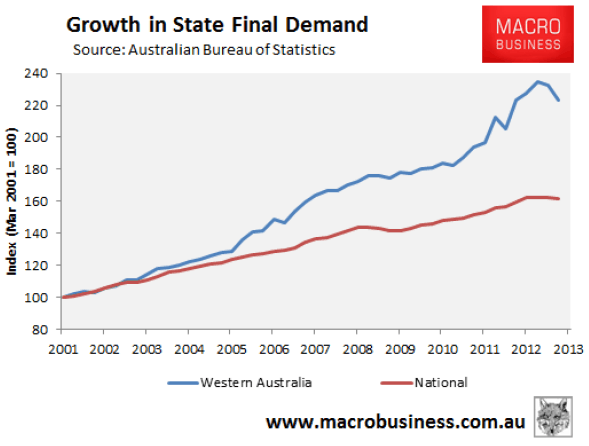
While there will be some quarterly volatility and questions around the trajectory of the decline owing to LNG investment, the overall trend will be down on general mining cost cutting with some big drops ahead as LNG projects enter commission.
The weakness has already spread to the Western Australian labour market, where annual growth in full-time jobs has slowed to a crawl, aggregate hours worked has turned negative, and the unemployment rate has risen by 1.2% over the past year (see next chart).
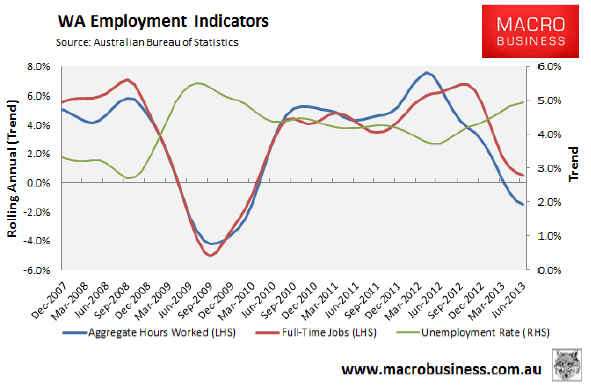
The slowing economy is also beginning to weigh on the Perth rental market, as evidenced by the rental vacancy rate trending-up strongly over the past nine months, albeit from very tight levels (see next chart). Should this this trend continue, which seems likely given the falling mining investment, then Perth rental growth is likely to stall, if not outright decline at some point in the near future.
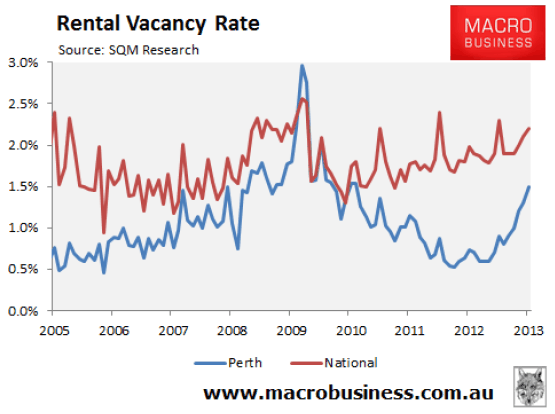
Perth house prices are also likely to come under pressure within the next 12 to 18 months as unemployment rises, income growth declines and migration into Perth slows (and even reverses).
Thus the three segments of housing market demand are likely to simultaneously come under pressure. Investors will take heat from reversing yields; first home buyer numbers will decline with population growth and up-graders will be confronted with a stalled property ladder, as well as weakening general conditions.
On this front, an examination of the smaller mid-1970s iron ore price boom is instructive. Shortly after Australia’s terms-of-trade peaked in 1974, Perth house prices increased to over 100% of the national average, before declining in a relative sense over the following decade as iron ore prices, and Australia’s terms-of-trade, collapsed (see next chart).
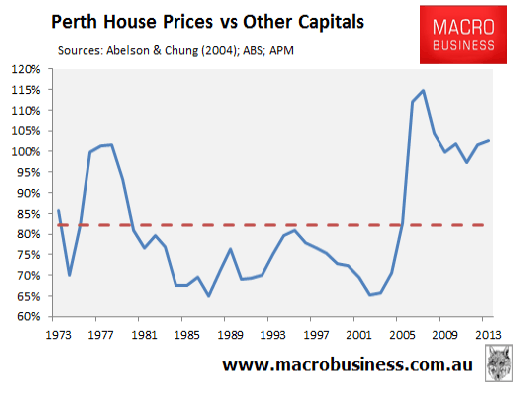
The mining price boom this time around is much bigger than that of the mid-1970s, and Perth’s house prices are, once again, sitting above 100% of the national average, having peaked at 115% in 2007. History suggests that as the mining investment boom and commodity prices unwind, Perth house values could once again come under significant pressure, falling relative to other Australian capitals and in absolute terms.
Bottom Line:
While Perth’s housing market has been a star performer recently, risks are building for the Western Australian economy, with both commodity prices and mining investment on the decline, which is likely to lead to sharply rising unemployment and falling income growth. The Western Australian Government also faces the prospect of a deteriorating budgetary position, as lower iron ore prices reduce mining royalties, which could potentially be met with cuts to public services and jobs.
While the timing of a possible downturn in Perth’s housing market is unknown, and could take 12 to 18 months to manifest, storm clouds are on the horizon. Following the end of the mid-1970s mining boom, Perth house prices declined by nearly 30% in inflation-adjusted terms over an eight year period. If history is any guide, similar falls could be in the offing over the next decade as Western Australia’s once-in-a-century mining boom unwinds.

